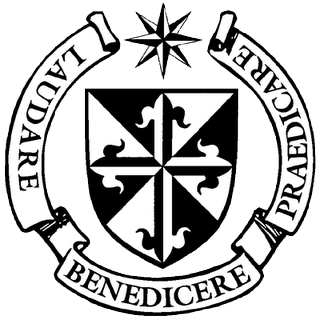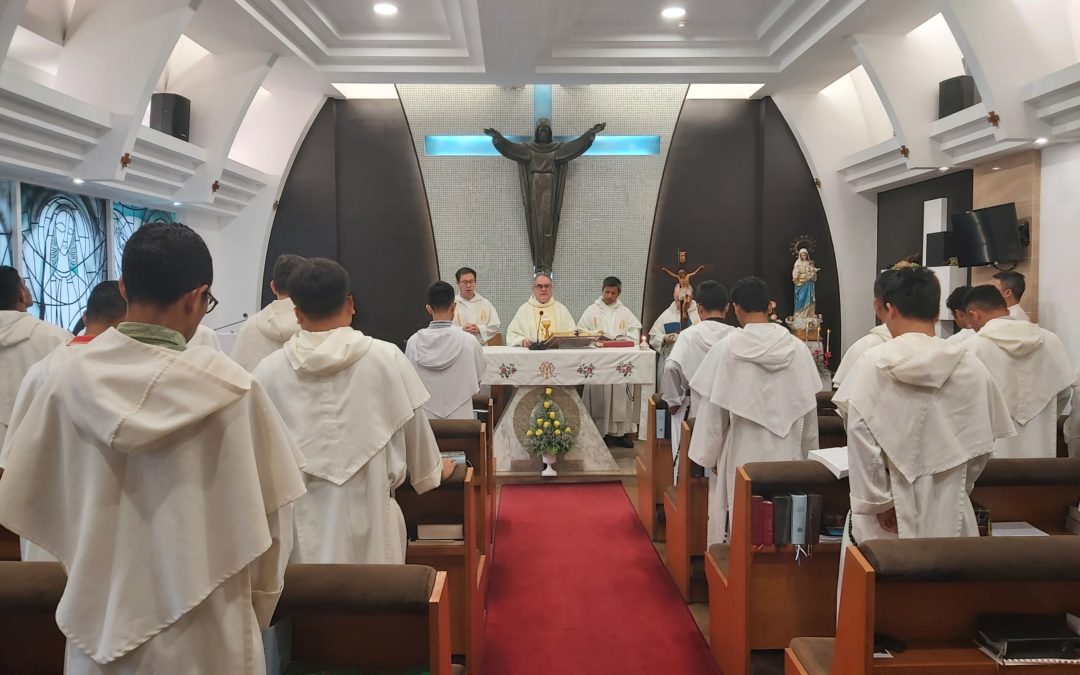
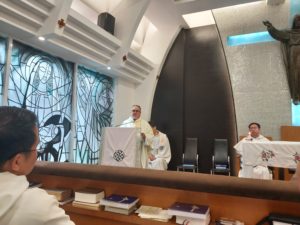
Today, October 7, 2023, the Priory celebrated the Solemnity of Our Lady of the Rosary. Here is the homily of our very own Fr. Javier Gonzalez, OP, Prior of St. Dominic Priory delivered during the solemn mass.
” On October 7, the Catholic Church celebrates the yearly feast of Our Lady of the Rosary.
We, too, as a community, are gathered together on this day to honor our Mother and Patroness. We are not simply praying to Mary, but we are praying with Mary in our midst, reenacting the scene of the Acts of the Apostles in the Upper Room, where the latter “with one accord were devoting themselves to prayer, together with some women and Mary the mother of Jesus, and his brothers.” (Act 1:14). Mary is in our midst, maternally watching over us that we do not miss the point of our very existence. With Mary we echo today her words: “The Almighty has done great things for me; holy is His name,” making them ours. With Mary we reaffirm, “My soul proclaims the greatness of the Lord, my spirit rejoices in God my Savior.” With Mary, we glorify God.
This solemnity of Our Lady of the Rosary has a prime Dominican flavor. From its beginning, the Order of Preachers showed special honor and devotion to Mary, Mother of God. The Ro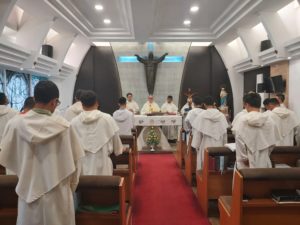 sary, which places before us the chief mysteries of the infancy, life, passion and resurrection of our Savior, has been one of the chief ways in which the Order has expressed this devotion.
sary, which places before us the chief mysteries of the infancy, life, passion and resurrection of our Savior, has been one of the chief ways in which the Order has expressed this devotion.
In 1208 the Blessed Virgin Mary appeared to St Dominic in the church of Prouille, France, and gave him a chaplet of beads representing roses commending to him the devotion which had spread among the faithful. St Dominic then gave the Rosary to his Sisters and Friars Preachers to use it in their efforts to convert the Cathars and the Albigensians in Southern France. It was indeed a powerful prayer.
Our brother Alan de La Roche (1428-1478) helped to define the structure of the Rosary and promoted its recitation. In 1470 he established the first Confraternity of the Rosary.
A century later, another member of the Order of Preachers, Pope Pius V, turned to the Virgin Mary in an hour of need. He began a rosary campaign through Europe for the Christian fleet at Lepanto, who was vastly outnumbered by the Muslim Turkish fleet. But the Christian soldiers were victorious. The Pope attributed the victory to the intercession of the Blessed Virgin Mary and established the feast of “Our Lady of Victory” on October 7, 1571. (Pope Paul VI renamed it “Our Lady of the Rosary” in order to remind the people of God how effective the Virgin Mary’s prayers are.)
Our Dominican Province, founded in 1587 “to preach the Gospel in the Philippines, in China and the rest of the nations of the Far East,” was recognized by the General Chapter of Venice [1592] under the title of Our Lady of the Rosary.
It has been a tradition in our communities the daily recitation of the Rosary, ended with the oldest known Marian prayer (“We fly to your patronage, O holy Mother of God; despise not our petitions in our necessities, but ever deliver us from all dangers. O glorious and blessed Virgin Mary.”)
“It has always been the habit of Catholics in danger and in difficult times to fly for refuge to Mary”, Pope Leo XIII wrote.
Pope Pius XII called the Rosary a compendium of the gospel. This expression was repeated by Pope Paul VI in Marialis Cultus. It is a form of contemplative, mental and vocal prayer, which brings down God’s blessing on the Church. It is a biblically-inspired prayer centred on the meditation on the salvific mysteries of Christ in union with Mary, who was so closely associated with her Son.
Pope John Paul II, in October 2002, with his Apostolic Letter Rosarium Virginis Mariae, made a landmark contribution to the prayer of the Rosary by adding the five luminous mysteries. He selected some significant moments in the life of Jesus: his Baptism, his first miracle at Cana, his Preaching of the Kingdom, his Transfiguration and the Institution of the Eucharist.
The Rosary appeals to many. It is simple. The constant repetition of words helps create an atmosphere in which to contemplate the mysteries of God. We sense that Jesus and Mary are wit
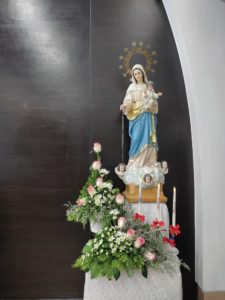
h us in the joys and sorrows of life. We grow in hope that God will bring us to share in the glory of Jesus and Mary forever.
As we celebrate the feast of Our Lady of the Rosary, our Patroness, let us remind her with filial devotion to turn her merciful eyes towards us now, and to show unto us
the blessed fruit of her womb, Jesus, at the end of our earthly exile.
Let us place under Mary’s maternal protection the Church, our Order, our communities, our families and our beloved ones.
Let us entrust to her our Province, our Missions currently spread in Asia (Philippines, Taiwan, Mainland China, Hong Kong, Macau, Japan, South Korea, Singapore, Myanmar, East Timor), in Europe (Spain, Italy) and in South America (Venezuela). Twelve countries, which I fancy represented in the 12 stars of Our Lady’s crown.
Our Lady of the Rosary, pray for us! “
[Fr. Javier Gonzalez, OP]
Macau, October 7, 2023
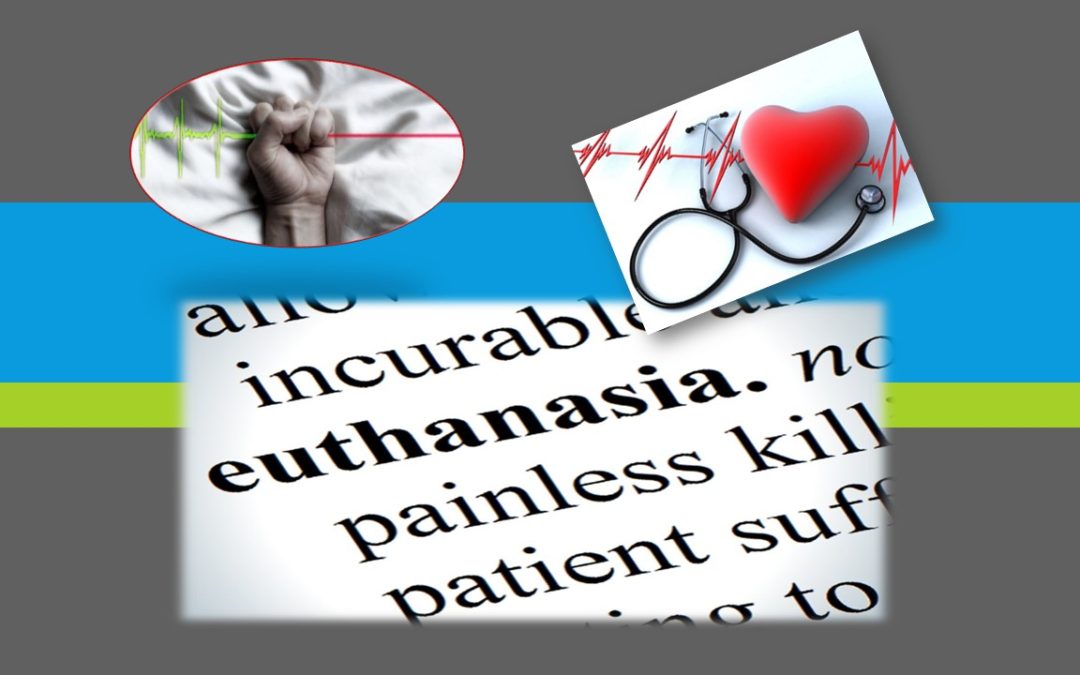
FAUSTO GOMEZ OP
A doctor writes: My younger brother John is suffering terribly due to a terminal brain cancer. Â He is asking me: Please, let me go. Watching him suffer so much, I am inclined to help him end his life.
I wish to share with you dear readers some thoughts on euthanasia and assisted suicide.
MEANING OF EUTHANASIA
There are different definitions of euthanasia. Etymologically, euthanasia means “good or happy death. From a humanist and Christian perspective, we define euthanasia as “An action or an omission which of itself or by intention causes death, in order that all suffering may in this way be eliminated (Vatican Congregation for the Doctrine of Faith; cf. CCC, no. 2277). Euthanasia, or direct killing, includes then a positive act (giving an overdose of painkillers) or an omission of obligatory treatment (a failure to feed). The writer speaks of euthanasia as direct or procured euthanasia that intends the death of a suffering patient.
A helpful and important distinction of euthanasia refers to the presence or absence of freedom on the part of the suffering patient: voluntary euthanasia, when the competent patient asks for it; involuntary euthanasia, when others choose death for the patient against his will, and non-voluntary euthanasia, when the stand of the patient is not known the case of children and those mentally disable – and surrogate decision makers or the courts impose it on him.
Objectively speaking, voluntary euthanasia (or self-killing) is suicide, while involuntary euthanasia (killing imposed on suffering patients by others) is cooperation in evil.
Connected with euthanasia is physician assisted suicide (PAS), that is, when a physician assists a gravely suffering patient by providing him with the instruments (terminal sedation with the purpose of ending his life) the patient needs to terminate his life.
IN FAVOR OF EUTHANASIA AND ASSISTED SUICIDE?
Unfortunately, the movement in favor of euthanasia is growing throughout the world, particularly in countries of the so West. The growing campaign for the legalization of euthanasia worldwide appears to be grounded on individualism ( choose how to live and how to die, a physically disable patient said recently); on hedonism (suffering is useless); on relativism (truth is relative and morality situational); and utilitarianism (the terminally ill may feel or be considered by others a useless burden).
The basic ethical principle of autonomy is generally used to defend and promote euthanasia and assisted suicide in our world. The recourse to voluntary euthanasia we are told – is an expression of individual autonomy and as a right to a dignified death.
Some authors and terminal patients defend the right to die.
Who can stop the slippery slope that is devaluing life in our secular world? With many other men and women – promoters of the culture of life -, we try to change the tide. “Yes, together we can!â€
Fortunately, there is also today a growing movement among believers and many others in favor of life and against the culture of death, including euthanasia and assisted suicide. We strongly believe in God’s Providence and grace.
AGAINST EUTHANASIA AND ASSISTED SUICIDE
In the Bible, God tells us: Thou shall not kill (Ex 20:13). As God creatures and children, we are custodians or administrators of our life under God, who is the Lord of life and death. For religious people, including Christians, human life is sacred, that is, precious, holy, worthy of reverence.The life of every person is sacred because he or she comes from God.
With all due respect, we affirm that euthanasia cannot be considered a dignified death, but Intentional killing, which entails a lack of true respect of human dignity and rights. It is against the fundamental right to life of every human being. Every human being has the right to life from the moment of conception to the moment of natural death.]
As human beings and as Christians, we defend and promote a consistent life-ethics: human life is like a seamless garment that ought to be respected at the beginning (against abortion) and at the end (against homicide, suicide and euthanasia – also against the death penalty). Vatican II says that euthanasia is one of the infamies of our time, and a grave violation of God law. St. John Paul II writes: The right to life means the right to be born and then continue to live until one natural end. Pope Francis keeps repeating that euthanasia and assisted suicide are evil manifestations of a throw away culture.
How may we speak of the right to die? As human creatures, we all have to die; we are mortal human beings. For each one of us, there is a time to be born, a time to live, and a time to die (cf. Eccl 3:2). There can be no right to die: killing is wrong, whether one does it (suicide), or others do it (homicide, abortion), or one does it with the help of others (assisted suicide). We decry the anti-life campaign which, based on a pragmatic and immoral notion of quality of life, appears to view some elderly persons, the handicapped and the vulnerable members of society as useless burdens to a family, a community, a nation: How could they not feel guilty for still being here, for costing so much, and for being so useless? That is a market mentality that leads to death (Eric Fuchs).
Regarding the argument of the autonomy of the patient, we may ask, what kind of autonomy may a deeply suffering patient have? As has been said, how may a patient use his autonomy to end with his life – and with his autonomy? More than patient autonomy, it might be a question of paternalism or eve manipulation of the patient by those others – be scientists, bioethicists, politicians and/or healthcare professionals or at times a family member.
The human person is not only free but also responsible, that is, he or she is autonomous and relational. His or her life is linked to others in solidarity. Every person belongs to a family, a community, a nation, the world. We remember an adult man who wanted to jump from a tenth floor of a condominium. He was using the phone. Someone shouted to him: “Remember you have a lovely daughter. Love convinced him not to jump. Individualism? No man is an island.
EUTHANASIA: FALSE COMPASSION
Euthanasia is also called mercy killing. May helping others commit suicide be merciful? Formal cooperation in suicide cannot be considered an act of genuine but of misplaced compassion, or false mercy. True compassion is a quality of genuine love – of love of neighbor. True compassion leads to sharing another pain; it does not kill the person whose suffering we cannot bear (St. John Paul II).
Although not always, generally assisted suicide is carried out by healthcare providers, particularly nurses and doctors. Ethically speaking, Physician assisted suicide (PAS) implies immoral formal cooperation in suicide. The physicians are asked by their profession to promote life and health: they are healers! The doctors (and nurses) most radical duty to their patients is primum non nocere, that is, first of all, do not harm. Compassion, Pope Francis says, is the soul of medicine. When Catholic physicians, or others, are asked to assist in suicide, they ought to reject it, following their right to conscientious objection, which a universal human right the right to follow personal conscience and/or the right to religious freedom.
Terminally ill patient John asks: Please, let me go. As a human being, as a Christian we are absolutely against euthanasia and assisted suicide. We are also united in compassionate and prayerful love with those who suffer, with the terminally ill patients, with John.
To the doctor we say: euthanasia is not an ethical but gravely unethical option and un-Christian. But, indeed, we are compassionately with John and in solidarity with his family. Euthanasia and assisted suicide – is not a moral answer to his terrible suffering from brain cancer. Certainly, there is for every human being a time to die, but not earlier through euthanasia and assisted suicide.
The doctor brother of John comments sadly: So my younger brother John continues suffering terribly! Just like that! Are there other options for him? Yes, doctor, there are. We shall continue our conversation next time.
(Published by O Clarim, Macau Catholic Weekly, May 26, 2017)
***
(READ) KILLING AND ALLOWING TO DIE: WHAT IS THE DIFFERENCE?
A reader asks: My cousin John is 48 years old. He is terminally ill with metastatic cancer and is suffering terribly. In this situation, what kind of “treatment may healthcare professionals offer to John?
Doctors may have three possibilities to choose from, namely, euthanasia (or killing), dysthanasia (or prolonging dying), and orthothanasia (or allowing to die, with palliative care). A more important question is this: I any of the three possibilities ethical? treatment may John be given?
Indeed, end-of-life issues are focused today on these three main problems: killing, prolonging dying and allowing to die. On this occasion, I have been asked to consider with you the following question: What is the difference between killing and allowing to die?
On this occasion, I shall study first killing (or euthanasia), secondly prolonging dying, third allowing to die, and fourth palliative care. Let us begin our journey by reflecting on euthanasia. What is the meaning and morality of euthanasia?
- EUTHANASIA
In the middle of the night, a sleepy gynecology resident is called to attend Debbie, a young woman, who is dying of ovarian cancer. He is horrified by her severe distress (“It was a gallows scene, he said later, âa cruel mockery of her youth and unfulfilled potential). Her only words to him were: Let get this over with.1
1.1 MEANING OF EUTHANASIA
There are different definitions of euthanasia. Etymologically, euthanasia means good or happy death.From a humanist and Christian perspective, we define euthanasia as: An action or an omission which of itself or by intention causes death, in order that all suffering may in this way be eliminated2 This point is substantially important: “If the aim is to bring about death, it is euthanasia, whether this is done by an omission (such as failure to feed or to cancel an order not to feed) or by a positive act.3
Regarding euthanasia, the main distinction is between active (or direct) and passive (or indirect) euthanasia. (When we speak of euthanasia without adjectives, we understand it as real euthanasia, that is, active euthanasia.)
What is active euthanasia? It is the directly willed inducement of death for merciful reasons;4 the death of the suffering patient may be done by commission, a positive act (for instance, giving an overdose of painkillers), or by omission of obligatory means (e. gr., failure to feed).
What is passive euthanasia? It is allowing to die. Active euthanasia is procuring death, while passive euthanasia, or allowing to die, is allowing death.5 Therefore, for us there is no equivalence between active and passive euthanasia; there is really a profound moral difference.
Some authors describe passive euthanasia thus: Passive euthanasia intends death by withholding (including withdrawing or refusing) available medical treatment or other care that clearly could enable a person to live significantly longer.6 From a Catholic perspective, this description speaks not of passive but of active euthanasia: it is active euthanasia by omission of beneficial obligatory treatment and by even intending death.
Is terminal sedation passive euthanasia? In our understanding of passive euthanasia, it is not, but active euthanasia. Terminal sedation is described as “administering morphine in doses that are intended to hasten death.
Another important distinction of euthanasia (meaning real euthanasia, that is, active, direct) refers to the presence or absence of freedom on the part of the patient. Thus, we speak of voluntary euthanasia, when the competent patient asks for it; and of involuntary euthanasia, when others choose death for the patient against his will. (There might also be non-voluntary euthanasia, that is when the stand of the patient is not known the case of children and those like children – or presumed to be in favor of it, and surrogate decision makers or the courts impose it on him/her).
At present, euthanasia is legal in Holland and in Belgium, and in the states of Oregon and Washington, of the United States of America. There is a growing campaign for the legalization of euthanasia worldwide. This loud campaign appears to be grounded on individualism (my life is mine), hedonism (suffering is useless), relativism (morality is plural and relative); and utilitarianism (the terminally ill may be useless burden). Who can stop the slippery slopethat is devaluing life in our secular world?
Assisted suicide is legal in Switzerland and Estonia. Assisted suicide is voluntary suicidal euthanasia (on the part of the patient) and homicidal euthanasia (on the part of the assisting person). (The case if Vincent Humbert, a 22 years-old Frenchman quadriplegic, whom his mother helped die in November 2003.)
1.2 MORALITY OF EUTHANASIA
The recourse to voluntary euthanasia is presented as an expression of individual autonomy and as a right to a dignified death; some speak even of a right to die!
The basic ethical principle of autonomy is generally used to defend and promote euthanasia in our world. But really, what kind of autonomy may a deeply suffering patient have? As has been said, how may a patient use his/her autonomy to end with his/her life and with that autonomy? Under the appearance of patient autonomy others perhaps, including the social environment, persuade certain patients to end their lives. More than patient autonomy, it might be paternalism or even the manipulation of the patient by those others be scientists, bioethicists, politicians and healthcare professionals.
Euthanasia (active, direct, intentional) is killing, one of the infamies of our time, and a grave violation of the law of God. And God said, “Thou shall not kill (Ex 20:13). Human life is sacred, that is,precious, holy, worthy of reverence; all human life is sacred, and not only at a certain level of the so-called quality of life, which is discriminatory against the weak and vulnerable members of society.
Every human being has the right to life from the moment of conception to the moment of natural death. As human beings and as Christians, we defend and promote a consistent life ethics: human life is like a seamless garment that ought to be respected at the beginning (against abortion) and at the end (against homicide, suicide and euthanasia and also against the death penalty). In his popular book Crossing the Threshold of Hope, Pope John Paul II writes: The right to life means the right to be born and then continue to live until one natural end.7 (Does capital punishment respect this natural end? It does not!).
The right to life, however, is not an absolute right for the person, because he is a steward of life. Only God is the Lord of life and death. Objectively, therefore, not only involuntary euthanasia (others choose) is immoral; voluntary euthanasia (patient asks for it) is immoral, too. In 1985, the French Bishops wrote: Active euthanasia, consisting in provoking directly the death of the sick person – including the laudable intention of removing his suffering introduces us into a world where very soon it will not be possible to live. Are we approaching this world?
How may we speak of a right to die? As human creatures, we all have to die; we are mortal human beings. As there is no “right to abortion, there can be no right to die: killing is wrong, whether one does it (suicide), or others do it (homicide, abortion), or one does it with the help of others (assisted suicide).
Connected with voluntary euthanasia is Physician Assisted Suicide (PAS), that is, when a physician assists a gravely suffering patient by providing him/her with the instruments this patient needs to terminate his/her life. Ethically, PAS implies formal or immediate material cooperation in suicide. The fact that a physician invented the so-called suicide machine is really tragic; it is ironic that this machine’s name is Mercitron. (Dr. Jack Kevorkian is the physician, who once was asked:What will happen after we die? His answer: We rot). Let us face it: mercy killing (another name for euthanasia) is merciless. While respecting the conscience of those who are in favor on euthanasia and loving them I add my voice to denounce the social campaign promoting euthanasia and physician-assisted suicide.
The doctors, in particular, are asked by their profession to promote life and health: they are the healers! How can patients (the whole wounded humanity) trust their doctors if they practice euthanasia or assist in suicide? The physician most radical duty to his/her patient is primum non nocere, that is, above all, do not harm. To kill is to harm. Killing cannot be considered a therapy, and, therefore, it cannot be a valid option for healthcare professionals. Cooperation in euthanasia, in killing, in suicide cannot be considered as it is often done an act of genuine but of misplaced compassion, or false mercy. It is a sin that cries out to heaven for vengeance and is always gravely immoral. True compassion is a quality of genuine love of neighbor. It means to be moved by the neighbor suffering and do something about it: True compassion leads to sharing another pain; it does not kill the person whose suffering we cannot bear.8 (On this point I disagree with Hans Jonas, who accepted the possibility of shortening, but never by a physician, the suffering and life of a dear one, out of love.)
True compassion, a quality of charity as love of neighbor, is totally opposed to assisted suicide. When physicians, or others, are asked to assist in suicide, they ought to appeal to their conscience and faith, and practice conscientious objection.
I am absolutely against euthanasia and assisted suicide, not only because I am a Christian, but also because I am a member of the human family. “Personal autonomy has as its first premise being alive and requires the responsibility of the individual, who is free in order to do good according to truth. He or she will come to affirm himself or herself, without contradiction, only in recognizing (even from a purely rational perspective) that he or she has received the gift of his or her life, of which, therefore, he or she cannot be the absolute master. To end life means in definite terms, to destroy the very roots of the freedom and the autonomy of the person.9
I decry that anti-life campaign which appears to view some elderly persons and the handicapped as useless burdens in a family, a community, a nation: How could they not feel guilty for still being here, for costing so much, and for being so useless? That is a market mentality that leads to death.10 Again I ask: what kind of autonomy do patients who ask for suicide really have?
Debbie, a 20-year-old woman with ovarian cancer has asked a gynecology resident to hasten her death. Her request: Let get this over with, doctor. His answer: a lethal injection of morphine! After reading this story (fictitious it appeared) involving physician-assisted suicide, four well-known American physicians questioned: What in the world is going on? And they commented: This issue touches medicine at its very moral center; if this moral center collapses, if physicians become killers or are even merely licensed to kill, the profession and, therewith, each physician – will never again be worthy of trust and respect as healer and comforter and promoter of life in all its frailty.11
We read in the Catechism of the Catholic Church: Direct euthanasia consists in putting an end to the lives of handicapped, sick or dying persons. It is morally unacceptable. It implies not only euthanasia by a positive act, but also by an act of omission: An act of omission which, of itself or by intention, causes death in order to eliminate suffering constitutes a murder gravely contrary to the dignity of the human person and to the respect due to the living God, his Creator.12
1 W. Gaylin, M.D., Leon R. Kass, M. D. Pellegrino, M. D., M. Siegler, M. D., Doctors Must Not Kill, JAMA, Vol. 259, No. 14, April 8, 1988, p. 2139.
2 Congregation for the Doctrine of Faith, Declaration on Euthanasia, Vatican City, 1980, Part II.
3 Helen Watt, Life and Death in Healthcare Ethics, London/New York: Routledge, 2000, p. 8.
4 William E. May, Human Existence, Medicine and Ethics, Chicago, Illinois: Franciscan Herald Press, 1977, p. 132.
5 Pontifical Academy for Life, Respect for the Dignity of the Dying Person, Vatican City, 2000, no. 6; in Osservatore Romano, 11-12 December 2000, p. 6.
6 G. P. Steward and Others, Basic Questions on Suicide and Euthanasia. Are They Ever Right? “Bioethics Series,Manila: Christian Literature Crusade 1998, p. 24.
7 John Paul II, Crossing the Threshold of Hope, New York: Alfred A. Knopf, 1994, p. 205.
8 John Paul II, Evangelium Vitae (EV), nos. 15, 57, 66; Catechism of the Catholic Church(CCC), no. 2268.
9 Pontifical Academy for Life, Respect for the Dignity of the Dying person, l.c., no. 5.
10 Eric Fuchs, “Social Justice in Health Care, Theology Digest, Vol. 45, No. 3, 1998, p. 217.
11 W. Gaylin, M.D., Leon R. Kass, M.D, E. D. Pellegrino, M.D., M. Siegler, M.D., Doctors Must Not Kill,†l.c., p. 2140.
12 CCC, no. 2277.
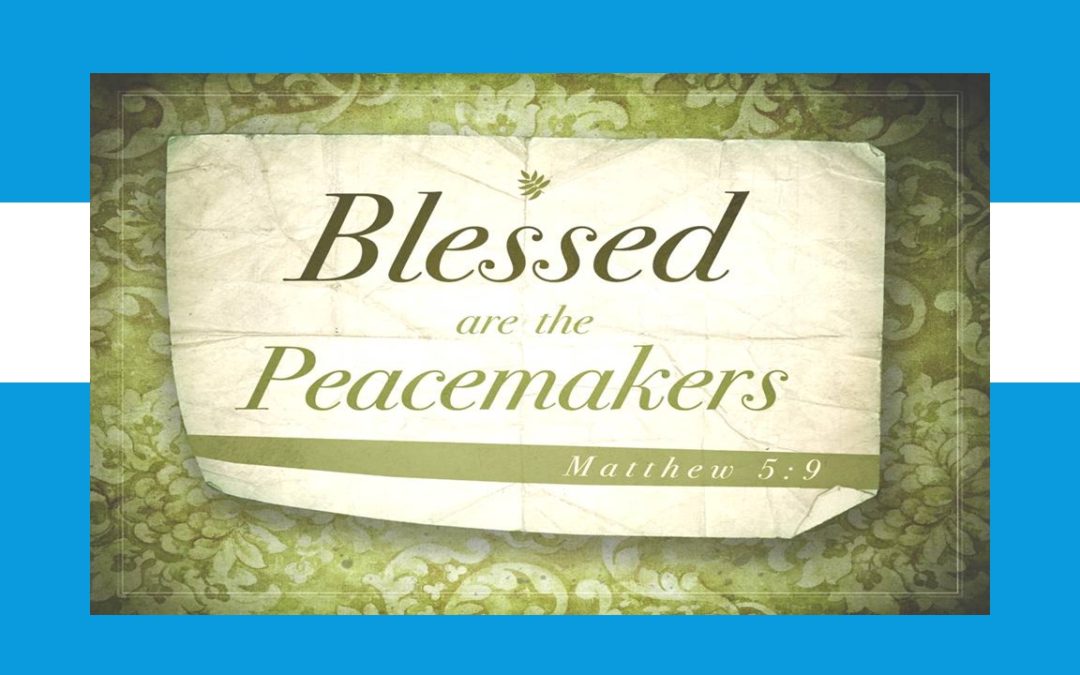
    The first day of every year is, for us Christians, the Solemnity of the Motherhood of Mary and International Day of Peace. I wish to share with you, the Message of Pope Francis.
    On January 1, 1968 Blessed Pope Paul VI inaugurated the year with the First Message of the World Day of Peace on The Day of Peace. On January 1, 2017 Pope Francis continued the fruitful tradition by celebrating the Fiftieth World Day of Peace with a powerful message entitled Nonviolence as a Style of Politics for Peace. Hereafter, I wish to present and reflect on this wonderful invitation of Pope Francis to all to be peacemakers through nonviolence.
    Why did Pope Francis select nonviolence as a peaceful style of life? Because violence continues to abound in our hearts and in our world. Unfortunately, we live in a “broken world,†in a “horrifying world†where war is fought piecemeal. Pope Francis cries out that there is “piecemeal violence†of different kinds and levels: “War in different countries and continents; terrorism, organized crime and unforeseen acts of violence; and the devastation of the environment†(2017 Message 1). There are weapon traffickers, and vast amounts of resources are spent for weapons of war while young and old people suffer terrible hardships. In our world, there are domestic violence and abuse of women and children (nos. 2, 4, 5).
    How may we fight violence nonviolently? Violence is fought and healed not by more violence but by active nonviolence.  Active nonviolence does not mean surrender, or lack of social involvement, or passivity. It overcomes the temptation to retaliate. Active nonviolence is a quality of authentic human and Christian love, which presupposes justice and respects truth.
    How to achieve fuller and wider peace in our world? Our common humanity and our faith command us to be peacemakers. One starts by acquiring internal and external personal peace. To be instruments of peace, we have to banish violence “from our hearts, words and deeds†(no. 7). We work for social peace by practicing equality, love and solidarity; by witnessing and promoting integral ecology, which means human dignity and rights, freedom, justice, truth and peace, and the integrity of creation.
    Is it hard to be peacemakers in our families, in our communities, in our world? We have amazing models to follow. Jesus, the model, proclaims nonviolence by his life and message. He walks the path of loving nonviolence “to the very end, to the cross, where he became our peace and put an end to hostility†(3). He preaches the unconditional love he lives, a love which shares with the needy and forgives all, including enemies. The Gospel of Jesus focuses on the Sermon on the Mount and the Good News of nonviolent love, on the eight Beatitudes: Blessed are the meek, the merciful, the peacemakers…
    Pope Francis mentions other well-known models of active nonviolence: St. Francis, St. Therese of the Child Jesus, and Saint Mother Teresa of Kolkata; Gandhi, Martin Luther King Jr, Leymah Gbowee and women. Pope Francis underlines the essential role of the family in promoting peace and nonviolence: “An ethics of fraternity and peaceful coexistence†starts in the family. All religions contribute to peace in the world. Pope Francis says that “no religion is terrorist, peace alone is holy, not war.â€
    The Pope from Argentina recalls the example of St. Therese and invites us to practice her “little way of love, not to miss out on a kind word, a smile or any small gesture which sows peace and friendship†(5). He brings to our attention the example and words of Saint Mother Teresa who says: “We in our family don’t need bombs and guns to destroy, to bring peace – just get together, love one another… And we will be able to overcome all the evil that is in the world†(3). Indeed, there is no way to peace, peace is the way (Gandhi). Hence, “We adopt the means of nonviolence because our end is a community at peace with itself†(Martin Luther King Jr).
    Pope Francis points out the forceful messages on loving and peaceful nonviolence of popes Paul VI, John Paul II and Benedict XVI. Who does not remember the piercing words of Blessed Paul VI at the United Nations in New York (October 4, 1965): “No more war! War never again! It is peace which must guide the destinies of peoples and of all mankind.†St. John Paul II proclaims: “Justice and forgiveness are essential to healingâ€; “May people learn to fight for justice without violence, renouncing class struggle in their internal disputes and war in international ones†(no. 4). Pope Francis quotes from the teachings about nonviolence of Pope Benedict XVI, who says:“For Christians, nonviolence is not merely tactical behavior but a person’s way of being, the attitude of one who is convinced of God’s love and power that he or she is not afraid to tackle evil with weapons of love and truth alone. Love of one’s enemies constitutes the nucleus of the Christian revolution†(3). I remember well the powerful statement of the Philippine Bishops just a few days before the EDSA peaceful revolution: “We insist, our acting must always be according to the Gospel of Christ, that is, in a peaceful, nonviolent way†(CBCP, February 14, 1986).
    In his fourth Message for the World Day of Peace (2017), Pope Francis makes a strong plea: “I plead for disarmament and for the prohibition and abolition of nuclear weapons.†The Pope adds: “Nuclear deterrence and the threat of mutual assured destruction are incapable of grounding†an ethics of “fraternity and peaceful coexistence between individuals and among peoples.†This ethics “cannot be based on the logic of fear, violence and closed-mindedness, but on responsibility, respect and sincere dialogue†(5).
    Active violence is also creative nonviolence: it actively creates new ways and methods and activities to achieve peace nonviolently in different situations and places. The world-wide movement of nonviolence relies radically on a deep spirituality which helps nonviolent peacemakers answer nonviolently any provocation. Nonviolence, a product of justice, truth and love is also, Pope Francis tells us, prayerful nonviolence: “Nothing is impossible if we turn to God in prayer. Everyone can be an artisan of peace†(7). The reigning Pope stresses the need of prayer to witness nonviolence in our life, to make nonviolent love the style of life.
    We celebrate today the Motherhood of Mary: Mary, the Mother of God. This is how she is called through the first centuries of Christianity. Mary is the Mother of Jesus, who is the Son of God and the Son of Mary: “She conceived, brought forth and nourished Christ; presented Him to the Father in the temple, and was united with Him in suffering as He died on the cross†(LG, 61). Mary is, certainly, the Mother of the Child Jesus, and also the Mother of the Crucified and Risen Lord. May Mary, the Mother of God and our Mother, the Queen of Peace (Regina pacis) help us all be committed to peace in our world – a world that longs for peace here, there and everywhere!
    In closing, two inspiring texts that come to mind: First keep yourself in peace and then shall you be abler to bring others to peace (Kempis). Acquire inner peace and thousands around you will find liberation (St. Seraphim).
(Fausto Gomez OP, Jan 1, 2017)
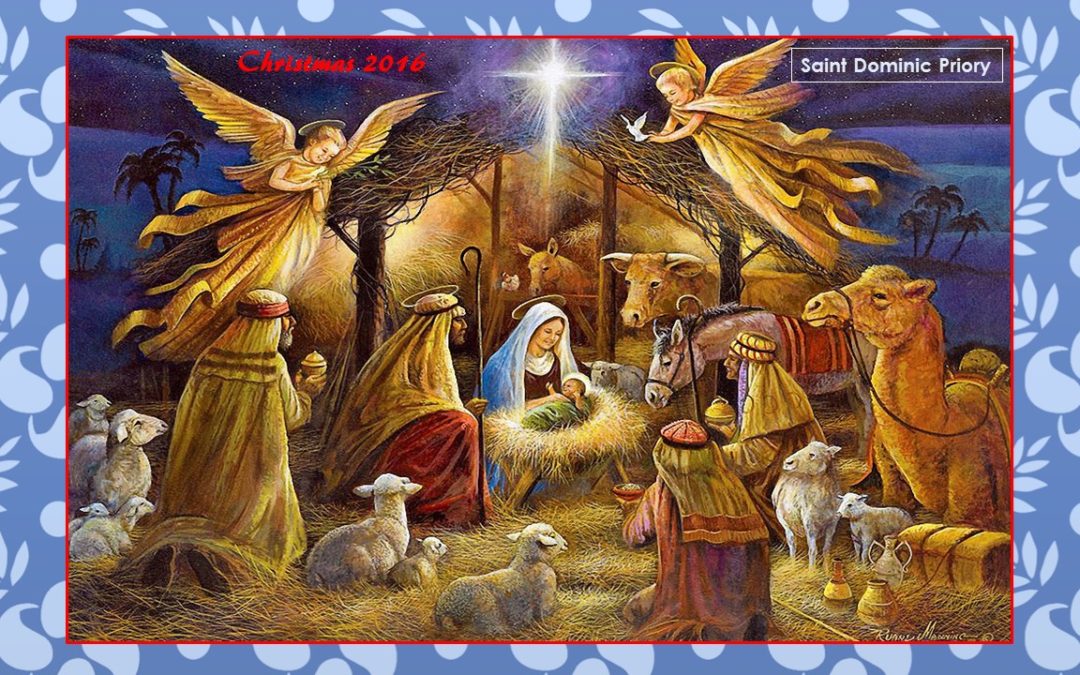
We are celebrating the Nativity of the Lord that takes place at about midnight when nature sleeps. It takes place tonight in our hearts and in our community as we re-live liturgically that first and glorious night.
The sacred readings inspire us. The prophet Isaiah cf. Is 9:1-6): “For a child is born to us, a son is given us… They name him Wonder-Counselor, God-Hero, Father-Forever, and Prince of Peace.†(It is also inspiring to listen to the Messiah of Handel) Saint Paul (Tit 2:11-14): “The grace of God has appeared saving all … The appearance of our great God and savior Jesus Christ.†St. Luke (Lk 2:1-14): (Angel to shepherds): “You will find an infant wrapped in swaddling clothes and lying in a manger.â€
We all know the meaning and the mystery of Christmas: “God so loved the world that He gave us his only Son.†Tonight and through the Christmas Season, we contemplate the Child Jesus in the crib. Let me share with you a few pointers that might be helpful to you as they are to me.
A Christmas Carol from Belgium tells us something truly moving: The shepherds go to offer gifts to the Child Jesus: cheese, honey, a lamb… One shepherd goes with empty hands. Why do you come to adore the little Child without any gift? The shepherd answers: “I only bring my surprise!†Every Christmas brings us believers an unimaginable surprise: “And the Word was made flesh and dwelt among us.†What a sublime surprise, what an amazing grace! What incomparable beauty. St. John of God loved to repeat: “If you wish to see and contemplate beauty on earth, ask the Lord to give you: eyes to see a young girl with a little child on her arms in a portico of Bethlehem. There is nothing more beautiful.†Blessed Angelico painted the crib and St. Dominic kneeling before the Child Jesus contemplating the mystery of Christmas, mystery of our faith: “He became what we are that we might become what He is†(St. Athanasius). How can this be? Â
A large family in a rural town goes to the Christmas Midnight Mass, except a young man who stays home because he cannot believe that God became man. This is – he said – impossible! There was that night a raging snow storm; it was windy and freezing. From the window of his room, he sees a flock of birds in the backyard: the birds are looking for shelter. He tries to help them by opening the door of the barn, but the birds are afraid and do not follow him to the barn. He puts bread crumbs along the way leading to the barn. No dice. He tries to befriend the birds by walking and raising his arms as if flying. Once again, no dice. Then he realizes something: “If only I could be a bird for a moment, perhaps I could save them.†At that very moment, the story goes, he hears the church bells ringing the Glory of Christmas and became aware of the mystery of the Incarnation: “Now – he says – I see why God has to become one of us, to save us†(from Louis Cassels). Jesus was born and died to save us and to show us the way to salvation and happiness – the way of love.
Sometime ago, little children presented a Play of the Nativity. All the teachers of the elementary and the parents of the children were present and eagerly waiting for the play to start. The angels came, the shepherds followed, and then Mary – very close to give birth – and Joseph. They were looking for a place to stay – and Mary, to give birth to Jesus. Mary and Joseph knocked at the door of the inn, and a little child of six opened the door. They asked him: “Please can we have a room for the night?†The boy innkeeper answered: “Sorry, there is no room in the inn.†But immediately the innkeeper changed his mind and said (and this he invented): “Hang on! Don’t go away. You can have my room†(from Margaret Silf).
“May Jesus have my room – my heart? May he have yours? “Each one of us is an innkeeper who decides if there is room for Jesus†(Max Maxwell). And, as we know – and as we feel by just imagining the real crib , the crib of Bethlehem -, a room for Jesus today means to be truly sensitive towards the needy – to a few concrete people who are in need in our midst.
This comment moved me to meditate: “Christ is always with us, always asking for room in our hearts…  I’m sure that the shepherds did not adore and then go away to leave Mary and her Child in the stable; but somehow found them room, even though what they had to offer might have been primitive enough. If we hadn’t got Christ’s own words for it, it would seem raving lunacy to believe that if I offer a bed and food and hospitality for Christmas – or any other time, for that matter – …my guest is Christ…†(Dorothy Day). On the background of the real manger we can read these invisible words from Jesus, the preacher:   “What you do to the least of my brothers and sisters you do it to me.†I am not trying to put too much seriousness on the joy and beauty of Christmas as a family feast. I am – aren’t we all? -for a joyful and beautiful and sweet Christmas. But true joy and beauty and sweetness are qualities of true happiness that only comes from solidarity with others and compassion to the needy – and God’s grace, which is always available to us. The real enemy of Christmas – of my happiness – is my selfishness, my “fat ego.†Therefore I am in need of “un-selfing.†Are you? Jesus is here to help us do what we can and pray for what we cannot.
And yes, by all means, “Glory to God in the highest and peace to all men and women.†My dear sisters and brothers: How do we respond to the unique surprise of the mystery of the birth of Jesus? How? By striving – I suggest – to celebrate Christmas with the right attitude. We celebrate the Birth of Christ in this Liturgy, that is, we re-live the birth of Jesus in the Liturgy and in our lives. We celebrate this Holy Eucharist with hopeful faith, joyful gratitude, and, above all, with an attitude of humble adoration.
Adoration means recognizing our radical dependence from God and from his grace. Humble adoration is the attitude of Christmas: it is the attitude of Mary and Joseph, who adore the child Jesus in awe and amazement; the attitude of the shepherds, who kneel before the crib with faith and humility; the attitude of the Magi, who present their gifts to the child as a symbol of their veneration of the Child.
May we all, lovers of Jesus, have a Blessed Christmas, that is, may Jesus continue growing in our hearts and may those around us notice it by the way we treat them with kindness and compassion.
Dear Mary, Mother of the Son of God and our Mother, help us all to have and live this blessed or happy Christmas. Amen.
(Fausto B. Gómez, St. Dominic Priory, Dec 24, 2016)
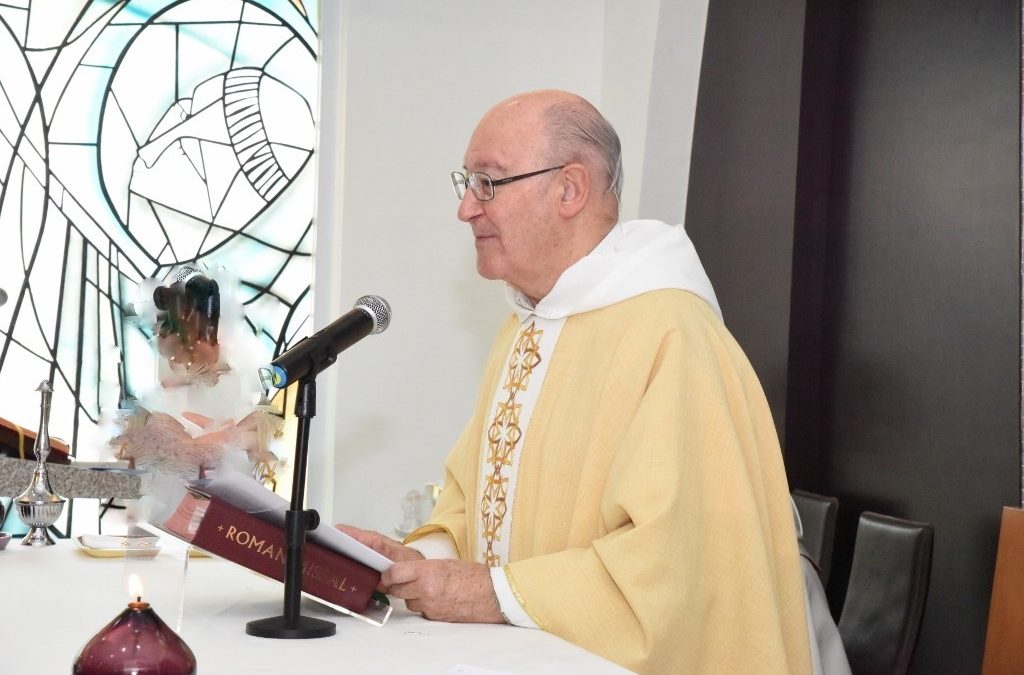
Jn 14, 23-29: “Do not let your heart be troubled, or afraid… I’ll be with you alwaysâ€
My dear Brother and Sisters, Friends. We Dominicans: Nuns, Sisters, Lay members of the Dominican Family and Brothers, promise to live everyday depending on God’s mercy and the mercy of the other members of the Community. As a poor mother begs the food to be able to feed her children, so we, preachers, have to beg for the Word of God, to be able to love Him more, and to feed our fellow men and women with it. How could we preach if we have not begged along the ways of this world the food of God’s Word?
Begging the Good News of the Gospel with the “soul of a poor†is the starting point for all true preaching, so seriously and urgently needed today. Thanks to his contemplative experience, Dominic de Guzmán, our founder, knew well that it was not possible “to speak about God†without first “speaking with Godâ€. It is not possible to preach without first receiving the Word of life as a gratuitous gift from God.
Some years ago, a close friend of mine, also Dominican, told me an anecdote in which he was involved, when still a young priest, in Guatemala: he was assigned to preside, early morning, the daily Eucharist for the people of a nearby village. On the way to the Church he used to pass near by the humble house of an elderly man, whom he found daily seating at the entrance of his house, with the Bible open on his knees. After a few days, my friend thought of approaching him and greet him in a more personal manner. “Good morning, Sirâ€, he greeted, “I’m fr. Ricardo and I see that you read the Bible every day. What are you reading today?â€. “Good morning to you, too, ‘Padrecito’†(affectionate way to address the priest), the aged man said. “I am Rubén Wamán, at your service!†“Look, ‘Padrecito’, it so happens, that I do not know how to read. But every day I ask “mi Diosito†–dearest God- for a Word for me and, already for many years, He has never failed me; everyday He gives me one word to mediate during the dayâ€â€¦ That was his main food, and his grace.
On another occasion, and in a different place, I attended an exhibition of pictures regarding the poor children of that nation: orphan, abandoned children, boys and girls of the street, soldier boys and victims of war, etc. I was particularly impressed by a young boy holding the picture –in black and white- of himself, at the foot which this legend could be read: “They know that I exist, but nobody sees me!â€
It is really painful what is happening in our present, tortured world, sometimes just in front of our own eyes. One is tempted to say, that it is better to have a heart of stone. And yet we know that it is not enough to limit ourselves to hear and see those places of suffering, and pass by as tourists of the crucifixion of the world. These are the places where theology should be made. It is in these places of Calvary where God can be found and a word of hope can be discovered… (T. Radcliffe, O.P.)
Unfortunately, similar anecdotes can be found almost anywhere. And somehow, we feel incapable of doing anything relevant, to make this our world more human, not to say more fraternal, as it is God’s will.
In today’s gospel, Jesus in his Farewell discourse, clearly states that, despite their being afraid to be left without their Teacher, they will not feel his absence: they will not be left alone, “I will come back to you…†Not only that, repeatedly Jesus tells them that they may count on his “Holy Spiritâ€, who will: a) teach them everything, b) make them remember everything that He had told them, c)tell them not to be worried or upset; not to be afraid d) defend them in the future from confusion and cowardice, e) give them peace: not just as a mere desire, but as a gift for them to keep; not as the world does, but as God does. If they obey, guided by the Spirit, keeping His Words, they will know peace, His peace.
And we should never forget, that to be a preacher of peace, an instrument of God’s peace, we need first to pacify our own heart, where the Father, the Son and the Holy Spirit want to dwell.
My dear Brothers and Sisters: Here, in front of you, we have some young ladies, who for already more than one year and a half, and always accompanied by Sister Malou Blanca, O.P., have been considering to join the lay branch of our Dominican Family, to share in our mission of preaching Jesus’ Word to this our world of today; mixed in the middle of the people, like the yeast in the dough, to be real witnesses of the Lord with their way of life – for after all, what really preaches is our life!-, and their joy, wanting to know more and more about Him every day, and living not only to love Him more, but within their own possibilities, also to share that love with their fellow sisters and brothers. Definitely, they have rejected the idea of the heart of stone, willing to dedicate their lives to the joyful and affectionate task of announcing the Good News brought about by Jesus with His promise of remaining, in His own way, with us until the end of time. That is the alternative of Jesus: a heart of compassion and tenderness; of salvation.
In a few more minutes, they will ask to join the 800 year old, yet- always-young, Dominican Family, thus adding the thousands of Lay Dominicans spread throughout the world. They are already much involved in pastoral work, catechetical instruction, etc. Now they will do their best to fortify the Community dimension of the Christian faith, sharing somehow in the life and mission of the whole Dominican Family, in their secular commitment with the Gospel.
In their name I beg you to say a little prayer to the Lord for them, so that their new experience of life, about to be started, become a radiant reality, and they may contribute to give much glory to the Good Lord, and bring peace and hope to our world.
José Luis de Miguel, OP
Macau, May 1, 2016
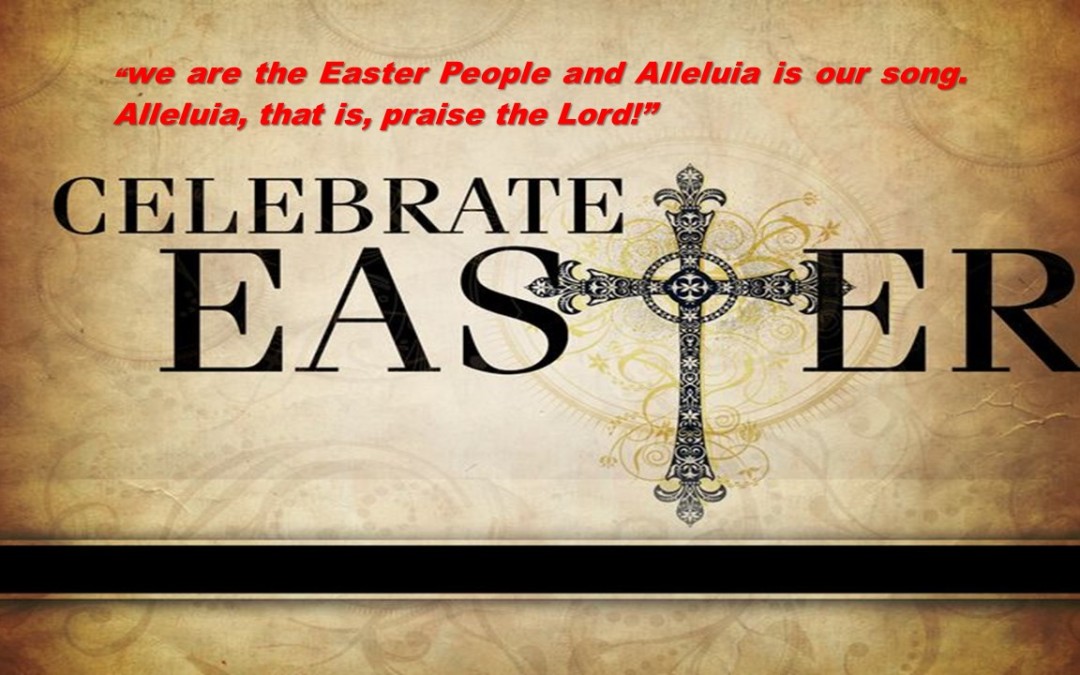
FAUSTO GOMEZ OP
A few days ago, a young man asked me: “What is the real meaning of Easter?†After conversing with him for a while, I went home and wrote a few thoughts on Easter. Let me share these thoughts with you, dear reader.
The Resurrection of the Lord is the Good News: “If Christ had not risen, our faith would be in vain,†St. Paul tells us. But Christ is risen, and, therefore, our faith is the true foundation of life, our hope looks to heaven and our charity is the step forward in our pilgrimage to the house of the Father. Someone asked Joseph of Arimathea: “Why did you give your great tomb to someone else (to Jesus)?†“Oh,†said Arimathea, “He only wanted it for the weekend.â€Â Kidding aside, the Lord is risen, He was raised to a new and glorious life, and He lives!
Christians through centuries, particularly the first disciples of Jesus, have proclaimed in words and deeds: We are Easter People! For us Christians, the resurrection of Christ is the central mystery of our faith. Saint Paul writes: “In the first place I taught you what I had been taught myself, namely that Christ died for our sins, in accordance with the scriptures; that he was buried, and that he was raised to life on the third day, in accordance with the scriptures†(I Cor 15:3-4).
To be a Christian yesterday, today and always means to be able to say with God’s grace – like Mary Magdalene, like the apostles – I have seen the Lord! To see the Lord in life implies to experience his presence as Crucified and Risen Lord, to be transformed by him, to be seduced by his life and mission. How may we know that indeed we have seen the Lord Jesus?
How did the first Christian communities show that they had experienced Christ’s transforming presence? Their answer: “They remained faithful to the teaching of the apostles, to fraternity, to the breaking of the bread, and to prayer… They shared their food gladly and generously, praised God and were looked up to by everyone†(Acts, 2:42, 46-47).
Is the Lord our Risen Lord? If we have encountered Jesus in our life, then he is raised from the dead. Where may we encounter the Risen Lord? We may encounter the Risen Lord in the praying and fraternal community, in the Church, which is the Mystical Body of Christ and a Community of Disciples: “Where two or three are gathered in my name, there am I in their midst†(Mt 18: 19-20). We recall that the apostle Thomas did not experience the presence of the Risen Lord when he was absent from the apostolic community.
We may encounter the Risen Lord in the Sacraments of the Church: in Baptism (the catechumens baptized on Easter Vigil experienced Jesus raised from the dead), in Penance, and above all in the Holy Eucharist: “This is my body,†Jesus said, “This is my blood†(Mt 26:28-28). Furthermore, we may experience the Risen Lord in the Word of God, the Sacred Scriptures, particularly when proclaimed in the Church. We remember the two disciples of Emmaus, who after recognizing the Lord in the breaking of the bread said to one another: “Were not our hearts burning inside us as he talked to us on the road and explained the Scriptures to us?†(Lk 24:32).
We may encounter Christ the Lord in our mission, in preaching and witnessing the Good News. This is the great resurrection command from the Risen Lord: “Go, therefore, and make disciples of all nations… And know that I am with you always, until the end of the world†(Mt 28:19-20). We may also feel the presence of Jesus in our lives if we love the little ones, that is, the poor, the sick, and the abandoned on the roads of life. These words of Jesus resound in our hearts in a special way through Easter: “What you do to the least of my brothers, you do it to me†(Mt 25:40). As it has been often said: Jesus is personally present (“I was hungry and you gave me foodâ€) in the “poor†and in those who are close to the poor.
How may we experience Christ’s resurrection, Easter today? We may experience him by turning away from sin, which is darkness, and by practicing virtue, which is light. Easter is light: the light of Christ, Jesus the Easter Candle. True Easter, according to Saint Athanasius, is abstention from sin, practice of virtue and the passage from death to life. But, how may one know that he or she has passed from death to life? “We know for sure,†St. John tells us, “that we have passed over from death to light because we love our brothers†(I Jn 3:14).
One fact from the Easter narratives that moves me deeply is the courageous, hopeful and joyful love of the apostles and the first Christians. These proclaimed the Word, focused on the death and resurrection of Jesus, in an incredibly bold manner. They were outrageously joyful – even in suffering and particularly in martyrdom. At times in our life, it is hard to be joyful. But we know that, as witnesses of the resurrection of Christ, our life ought to be permeated essentially by joy.
Are we Easter People? Indeed, we are: We Christians firmly believe in the resurrection of Jesus the Lord. His Resurrection is the guarantee of our own resurrection: “Christ has been raised from the dead, as the first-fruits of all who have fallen asleep. As it was by one man that death came, so through one man has come the resurrection of the dead. Just as all die in Adam, so in Christ all will be brought to life†(I Cor 15:20-22).
Believers in Jesus are Easter People and strive hard to behave as witnesses of his resurrection – of his unconditional and universal love. Indeed, we are Easter People and Alleluia is our song. Alleluia, that is, praise the Lord!
May those around us notice that we are Easter People by the way we treat them with kindness and compassion. Dear co-pilgrim on the journey of life…, Happy Easter!
(Published by O Clarim: March 24, 2016)


 sary, which places before us the chief mysteries of the infancy, life, passion and resurrection of our Savior, has been one of the chief ways in which the Order has expressed this devotion.
sary, which places before us the chief mysteries of the infancy, life, passion and resurrection of our Savior, has been one of the chief ways in which the Order has expressed this devotion.
